Maryland
| |
|
Accokeek |
Maryland |
USA |
Armillary Sphere |
Dial 118 |
| Copper armillary dial 18 inches diameter. Two main rings are square1/2 inch tubing. Other parts of armillary are made of flat copper, about 3/4 inch wide. Has Roman numerals. Probably built by Ferguson family and installed in the 1920's. The dial base is cast cement, partly fluted, about 3-1/2 foot high, round at top, square at bottom. |
| |
| |
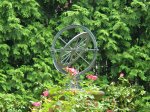 |
Annapolis |
Maryland |
USA |
Armillary Sphere |
Dial 765 |
| A bronze armillary dial with meridian, horizon and equatorial rings on a concrete pedestal. Dial is located in Government House residence and requires a tour of the property for access. |
| |
| |
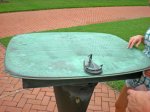 |
Annapolis |
Maryland |
USA |
Obelisk or Vertical Gnomon |
Dial 174 |
| 4'x4' Bronze & Brass 4' Dial plate is elaborately engraved bronze with hour and date lines. Self-orienting dial. Locate line for the date; rotate dial until shadow tip touches that line. Read time from intersection of the shadow's tip and the time line radiating from dial center. Gnomon is a model of a naval missile, resting on an anchor. A ship's binnacle supports rotating sundial plate. |
| |
| |
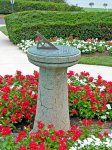 |
Annapolis |
Maryland |
USA |
Horizontal Dial |
Dial 181 |
| Farenholt sundial for U.S. Naval Hospital Annapolis MD. This cast bronze dial was designed and commissioned by RADM Farenholt for U.S. Naval Hospitals at bases where he was commanding officer, visited, or had special meaning to him. The dial is 18 inches (46cm) in diameter. The outer chapter ring has the motto, followed by a chapter ring with Arabic hours 6am to 6pm, raised hour lines that radiate from near the foot of the gnomon and short half-hour lines. The gnomon has graceful curves and a trefoil or quatrefoil cut-out in the center. Below the gnomon is the naval command name, followed by the commissioning date in the southern portion of the hours chapter ring. |
| |
| |
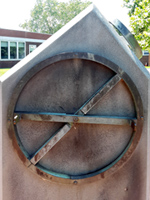 |
Annapolis |
Maryland |
USA |
Noon Mark or Meridian Dial |
Dial 1036 |
| This brass mariner's compass about 12 inches in diameter is mounted on the east side of a concrete pillar. It is known on campus as "The Ptolemy Stone". It functions as a meridian transit with altitude marks every half degree engraved on the upper south quadrant. The alidade has a notch on the upper end and a plate at the lower end, designed for measuring the altitude of the sun using the notch shadow (preventing eye damage of sighting the sun directly). The pillar is just over 3 feet tall with a sloped top. The main slope is that of the site latitude. A steeper "north face" is cut plane to the celestial equator. To make the equator "visible", a ring is mounted to the face. The ring casts no shadow on the equinox and from September to March is in shadow. A similar Ptolemy Stone is at St. John's campus in Santa Fe, NM. |
| |
| |
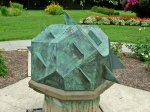 |
Baltimore |
Maryland |
USA |
Polyhedral Dial |
Dial 91 |
| Bronze on stone. Renovated 1904 and again in 1994 (by George McDowell.). It is a 17-facet hemispherical compendium dial. Has facets calibrated for local solar time for Baltimore, Jeddo [Tokyo], Honolulu, Sitka, Pitcairn Islands, San Francisco, Cape Cod, Rio Jancito, London, Fernano Po, Cape Town, Jerusalem, and Calcutta. Has a polar and vertical dial for Baltimore time. Built in 1892 by Peter Hamilton, 19th C Baltimore stonecutter, became president of the company which supplied granite for the Library of Congress building. Repaired and reset in 1904. Reworked in 1993. The original pedestal remains, consisting of a stone pillar carved to resemble the trunk of a tree. |
| |
| |
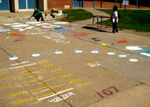 |
Baltimore |
Maryland |
USA |
Analemmatic Dial |
Dial 843 |
| Volunteers painted a 16 x 5 foot analemmatic dial for the elementary and middle school students. The dial has 8-inch circles for hour numbers from 5am to 7pm using standard time. The dial walkway is painted with yellow month lines and abbreviations for each month to the side. The words "summer" and "winter" are at the solstice lines. Bailey points are painted as small yellow circles to indicate the direction of sunrise and sunset from the observer's position on the walkway. |
| |
| |
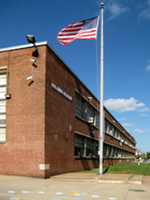 |
Baltimore |
Maryland |
USA |
Analemmatic Dial |
Dial 844 |
| Volunteers painted a 16 x 5 foot analemmatic dial for the elementary and middle school students. The dial has 8-inch circles for hour numbers from 5am to 7pm using standard time. The dial walkway is painted with yellow month lines and abbreviations for each month to the side. The words "summer" and "winter" are at the solstice lines. Bailey points are painted as small yellow circles to indicate the direction of sunrise and sunset from the observer's position on the walkway. |
| |
| |
 |
Baltimore |
Maryland |
USA |
Equatorial Dial |
Dial 327 |
| The dial is a partial cylinder held upright at the proper angle by four ornate pillars. The gnomon is a wire stretched between another pillar at the south edge and the mouth of an eagle mounted on another pillar at the north edge. On the wire is a bead, the shadow of which falls on the cylindrical plate. The cylindrical plate has an analemma for each daylight hour of standard time.' (McDowell) One of three known to be made in this design. Another dial of this design, once in front of the Physical Laboratory at Northwestern University, was placed at a private residence in New Hampshire in 1973, Evanston, IL. |
| |
| |
|
Baltimore |
Maryland |
USA |
Horizontal Dial |
Dial 326 |
| Very bad small dial on a beautiful stone pedestal. The engraving on the base states that it was erected in 1908. At some point the dial face went missing. A new dial was installed sometime before 1966. It is doubtful that the existing dial is a replica of the original. The stylistic differences between the design of the pedestal and the design of the new dial which sits atop it are apparent. The gnomon is now missing from the dial. |
| |
| |
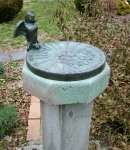 |
Baltimore |
Maryland |
USA |
Horizontal Dial |
Dial 325 |
| A 12 inch diameter horizontal bronze dial. A wire is stretched from the dial's center, which is decorated as a cluster of flowers, to the beak of a bird perched on the rim of the dial plate, forming the gnomon at proper angle. The bird is apparently the 'early bird' eating the worm (gnomon). The dial plate itself has hour lines and Roman numerals from 5 am to 7 pm. Dial sits atop a cast concrete post with octagonal top. |
| |
| |
|
Baltimore |
Maryland |
USA |
Horizontal Dial |
Dial 324 |
| A horizontal dial 36 inches in diameter, made of bronze, sitting on an irregular pentagonal block of granite. Gnomon missing. Calibrated to read local solar time, and has a graph of the Equation of Time to correct readings to standard time. |
| |
| |
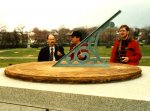 |
Baltimore |
Maryland |
USA |
Horizontal Dial |
Dial 323 |
| Nice horizontal dial sitting on a 6 x 4 foot stone pedestal. The dial itself is 5 foot in diameter with a 2.5 foot gnomon of open-work bronze. The lines, numerals and lettering of the dial face are so finely done that one cannot tell whether the dial plate was made of cast stone or was carved by an extraordinarily skilled mason. The gnomon, unfortunately, is situated incorrectly on the dial face. The point at which the stile diverges from the dial plate is about five inches south of the correct point where the hour lines converge. |
| |
| |
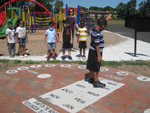 |
Baltimore |
Maryland |
USA |
Analemmatic Dial |
Dial 1015 |
| This red brick analemmatic is an ellipse 18x12 feet. It has concrete stone inlays for the zodiac walkway and hour stones from 5am to 7pm in black lettering. At the edges are markers for the cardinal points and along the east-west line are the seasonal points (Bailey Points) for determining the direction of the rise and set of the sun. |
| |
| |
 |
Baltimore |
Maryland |
USA |
Vertical Dial |
Dial 243 |
| 18 x29 inch vertical dial. Solar noon analemma, equinox and solstice lines, horizontal lines, line showing approx shadow lengths on April 15 and Aug 31. Lines sandblasted into veined white Carrera marble. Dial is calibrated for EDT. AM hours indicated by shadow of stile's western edge, PM, by shadow of its eastern edge. When shadow tip is bisected by appropriate seasonal segment of the line of the analemma, it is 1:06:35 PM. |
| |
| |
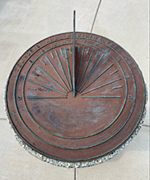 |
Bethesda |
Maryland |
USA |
Horizontal Dial |
Dial 258 |
| Farenholt sundial for U.S. Naval Center Maryland. This cast bronze dial was designed and commissioned by RADM Farenholt for U.S. Naval Hospitals at bases where he was commanding officer, visited, or had special meaning to him. The dial is 18 inches (46cm) in diameter. The outer chapter ring has the motto, followed by a chapter ring with Arabic hours 6am to 6pm, raised hour lines that radiate from near the foot of the gnomon and short half-hour lines. The gnomon has graceful curves and a trefoil cut-out in the center. The dial base is on a stone pillar. The dial sits in a shallow stone bowl about 3 feet from the ground. |
| |
| |
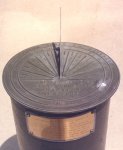 |
Bethesda |
Maryland |
United States |
Horizontal Dial |
Dial 461 |
| Farenholt sundial for U.S. Naval Hospital Brooklyn NY. This cast bronze dial was designed and commissioned by RADM Farenholt for U.S. Naval Hospitals at bases where he was commanding officer, visited, or had special meaning to him. The dial is 18 inches (46cm) in diameter. The outer chapter ring has the motto, followed by a chapter ring with Arabic hours 6am to 6pm, raised hour lines that radiate from near the foot of the gnomon and short half-hour lines. The gnomon has graceful curves and a trefoil cut-out in the center. Below the gnomon is the naval command name, followed by the commissioning date in the southern portion of the hours chapter ring. |
| |
| |
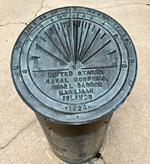 |
Bethesda |
Maryland |
United States |
Horizontal Dial |
Dial 462 |
| Farenholt sundial for U.S. Naval Hospital Pearl Harbor, Hawaiian Islands. This cast bronze dial was designed and commissioned by RADM Farenholt for U.S. Naval Hospitals at bases where he was commanding officer, visited, or had special meaning to him. The dial is 18 inches (46cm) in diameter. The outer chapter ring has the motto, followed by a chapter ring with Arabic hours 6am to 6pm, raised hour lines that radiate from near the foot of the gnomon and short half-hour lines. The gnomon has graceful curves and a quatrefoil cut-out in the center. Below the gnomon is the naval command name, followed by the commissioning date in the southern portion of the hours chapter ring. |
| |
| |
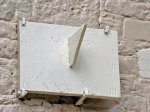 |
Bowie |
Maryland |
USA |
Vertical Dial |
Dial 372 |
| A small vertical stone dial with a weathered wood gnomon is mounted with iron brackets to the wall of Sacred Heart Chapel. The dial is about 26 inches wide by 16 inches high. The inscribed longitude of 00 deg 20 min East is correct for the United States Prime Meridian which goes approximately up 16th Street in Washington DC. In 1853, fire destroyed everything but the walls of the chapel; it was reconstructed in 1858. The present stone dial is reported to have been made by Francis J. Deutsch, Sr., replacing and duplicating the original. See NASS Compendium Vol. 5, No. 3, Sept., 1998. The whole dial is now covered with white paint and the gnomon which is set at 42? is placed upside down. The wall is 7? SE but the dial was designed for true south. |
| |
| |
 |
Bowie |
Maryland |
USA |
Vertical Dial |
Dial 712 |
| The Bowie Portal Dial is a 48x66 inch vertical dial of frosted glass atop two 15 foot tall steel beams. The dial face has bronze filigreed hour lines, Roman hour numerals and a supported bronze gnomon. The translucent glass allows the dial time to be read from both sides. At ground level the two steel beams are surrounded by steel benches covered in granite and form a portal with the silhouette of playing children cut of brass sheet riveted to the stainless steel base. The 11 foot wide base depicts running horses cut in brass and sits atop a 16 foot diameter compass rose. The base includes a plaque with the EOT. |
| |
| |
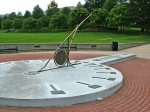 |
College Park |
Maryland |
USA |
Horizontal Dial |
Dial 260 |
| Very large horizontal dial 25 foot in diameter. Concrete dial with bronze gnomon 6' 6" high at tip. Has hour markers on raised circular slab. Metal disc with university seal in center of pierced gnomon. Adjacent graph provided correction for both EOT and mean/standard time differences. Due north or gnomon are shadow markers for date of year. Relocated May 1991 to present site. |
| |
| |
 |
Gaithersburg |
Maryland |
USA |
Polar Dial |
Dial 51 |
| Briggs Commemorative Sundial. One of the more complex and elaborate ones in the US. The dial plate lies parallel to the earth's axis of rotation. The dial has three gnomons. The upper and lower point out Eastern Standard time, the middle one indicates local apparent (solar) time throughout the year. A copy of the brochure is in the NASS Archives. |
| |
| |
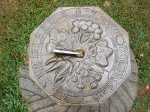 |
Hagerstown |
Maryland |
USA |
Horizontal Dial |
Dial 701 |
| A 16 inch octagonal bronze horizontal dial with hour lines and Arabic numerals. Dial face includes boldly raised representations of five different flowers identified by botanic names. Original gnomon has been replaced. Dial is placed atop an octagonal concrete pedestal with stone base. |
| |
| |
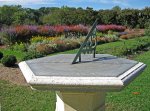 |
Hollywood |
Maryland |
USA |
Horizontal Dial |
Dial 373 |
| A 26 inch hexagonal, English-made slate horizontal dial with a 3/8-inch thick, knife-edge bronze gnomon and no noon gap. Dial face has hour, half-hour and quarter-hour marks in inner bands, and 3-minute marks in the outer band. Hours are marked with Roman numerals.
The dial sits on a hexagonal pedestal carved with coats-of-arms of families that lived at the plantation, including the Plater, Briscoe and Satterlee families.
The dial face has four concentric bands of hour numerals. The outer band reads local time with an inscription that notes local noon is also noon at Boston, Peru and C. Redondo, and midnight at Borneo and Chinese Tartary. The second band shows noon in New Zealand, London and other locations. Two additional inner bands show noon in still other cities around the world.
The plantation house overlooking the Patuxent River was constructed between 1710 and 1717 by James Bowles. Bowles died in 1727 and Sotterley Plantation passed through Plater and Briscoe ownership. The plantation was bought by Herbert L. Satterlee in 1910 and restored, including his vision of an 18th century garden in which he placed this sundial, received as a gift, in 1925.
Admission fee is required. Call 301-373-2280 for hours. |
| |
| |
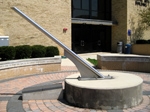 |
Rockville |
Maryland |
USA |
Horizontal Dial |
Dial 823 |
| A simple stainless steel gnomon 5-inches in diameter sits on a 6-foot concrete dais. Surrounding the dais are brick pavers with two circular bands of granite pavers. The interior band is for daylight saving time hours of engraved numbers filled with a gold color and a similar outer band for standard time hours. The granite pavers also mark the cardinal points engraved in gold, and extended as east-west and north-south lines from the dais. What makes this dial both unique and beautiful is the low brick and concrete surrounding walls with inscriptions from famous authors on both the interior and exterior faces. |
| |
| |
 |
Rockville |
Maryland |
USA |
Reflective Equatorial |
Dial 1108 |
| One of Bill Gottesman's unique-design Renaissance dials of cast and structural bronze with a 27 inch diameter helix with a celestial-north aligned axis. Time is told by a focused beam of light that moves around the helix throughout the day. The light beam is reflected from a long cylindrical unsilvered mirror in a structure that supports the helix. A sliding time scale within the helix can be adjusted for EOT and DST and includes longitude correction. Once this scale is adjusted for date, the dial shows civil, or clock, time. The dial base is cast bronze allowing adjustment for latitude and placed on a concrete pedestal with a black granite plinth. |
| |
| |
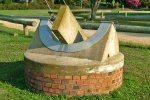 |
St. Mary's City |
Maryland |
USA |
Equatorial Dial |
Dial 374 |
| Cement half-cylinder acting as an equatorial time ring with an inside radius of about 18 inches and a concrete gnomon 5 inches thick that looks more like a piece of lumber set on edge than a gnomon. There is no nodus such that the gnomon shadow is a straight line on the wide equatorial band. The cylindrical inner face is stainless steel with an engraved grid of quarter hours and months. The hours are marked in Arabic every half hour and at every hour is a graphical curve of the equation of time (EOT). Using the time of month, one reads across from the month mark to the EOT, giving the time offset. All in all, a very clear way of integrating the EOT with the hourly shadow. |
| |
| |
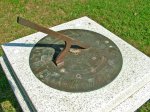 |
Sunderland |
Maryland |
USA |
Horizontal Dial |
Dial 259 |
| A brass horizontal dial 11.5 inches in diameter with a 7 inch high gnomon. The dial is intricately engraved and includes compass points and gradations of the clock to two minutes. Made by "E. Nairne", a London dial maker in the 1750's to 1800. Rector Stephanie Chase Wilson says "I believe it was made specifically for our church as it has the name "All St.s Parish Calvt County" written on the face on the opposite side from "E. Nairne." The oral history of its origins is that it was commissioned by the Rev. Thomas Claggett, rector of All Saints from 1769-1777, and again from 1786-1792. He gave the sundial to the church in thanksgiving for being called as the first Bishop consecrated on American soil on September 17, 1792 in Trinity Church, New York."
"About 15-20 years ago the sundial was stolen from the church, but a quick-thinking parishioner got word out to every antique store within 100 miles and several days later it was recovered. A replica was created and now sits outside the church on a pedestal. The original is under lock and key. The only special care it gets is an occasional dusting. " |
| |
| |
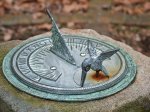 |
Towson |
Maryland |
USA |
Horizontal Dial |
Dial 334 |
| A bronze horizontal dial made inscribed "1715". About 10 inches in diameter with an ornately decorated dial plate.
The original gnomon has been removed and a modern garden sundial placed over the original dial face; little of the original face is visible. The dial is on a square stone that sits atop a plane square cut stone pillar. |
| |
| |
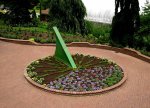 |
Wheaton |
Maryland |
USA |
Horizontal Dial |
Dial 503 |
| A 20 foot diameter horizontal dial in the middle of a brick patio. The gnomon, about 12 inches wide and 8 feet tall, is made of thin wood painted a verdant green and edged with molding. The dial face is a bed of flowers with hour lines of small plants, all immaculately kept by gardener and dial builder Roger Haynes. Around the circumference of the dial are Arabic number placards for each hour from 6am to 6pm. The flowers are changed seasonally for a gardener?s delight, and during the winter when the plants are dormant, the gnomon is removed and the area is used for a winter light show. |
| |